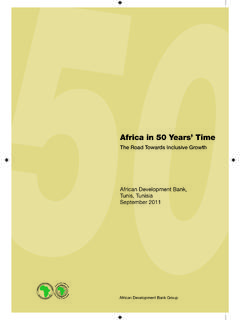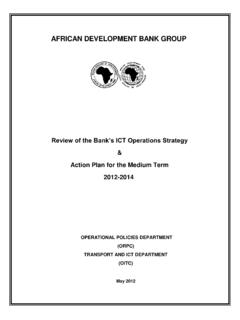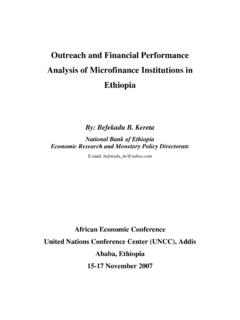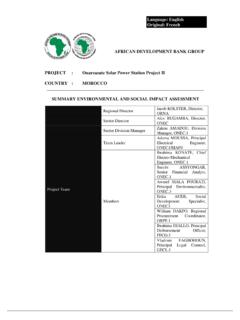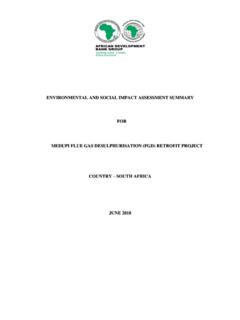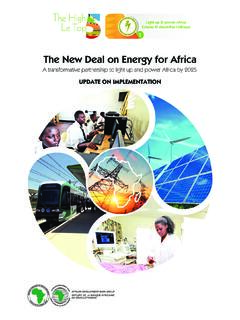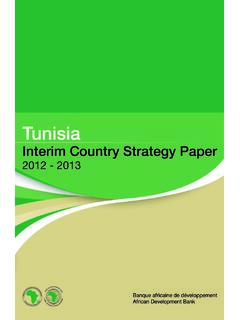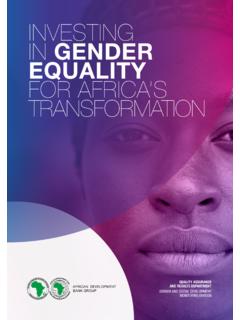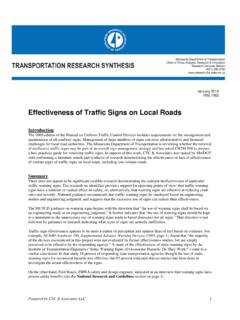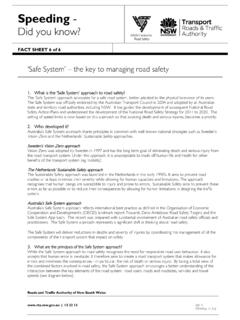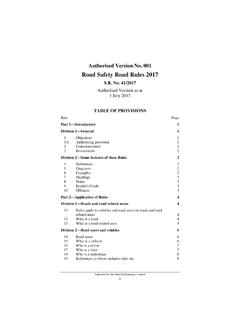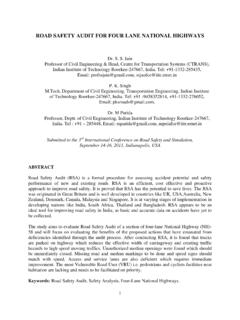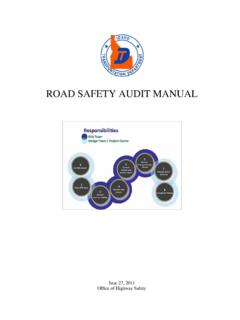Transcription of Road Safety in Africa - African Development Bank
1 road Safety in AfricaAssessment of Progresses and Challenges in road Safety Management SystemTransport & ICT Department,December 2013iAfricAn Development BAnk GroupDepartment of Transport and ICT, OITCP repared by : Girma Berhanu BEZABEH Transport Engineer, OITC2 Sector Manager (OIC) : Mamady SOUARE Sector Director : Amadou OUMAROU December 2013 AcknowledgementThis assessment on road Safety management system was undertaken by the African Development Bank (AfDB) as part of its economic and sector work program for mainstreaming road Safety . The objective of the study is to obtain information on country road Safety legal and institutional issues, technical and managerial capacity, financing and performance of road Safety programmes (if existent). Furthermore, it is also intended to get facts on the scale of the human and economic losses caused and characteristics of road crash to examine the complex multisectoral road Safety issues. The findings of the study will be the basis for promoting road Safety at regional and country levels.
2 The study will further help to ensure that the road Safety initiatives are aligned with the Bank s Ten Year Strategy in building regional and local capacity for sustainable road Safety in Africa . The author of the report is Girma Berhanu Bezabeh, Transport Engineer, The economic and sector work was under-taken under the overall guidance of Amadou Oumarou, Director of the Transport and ICT Department of the Bank. The Report was reviewed by Aaron Mwila, Transport Engineer, , Emelly Mutambatsere, Research Economist, SARC, and Zerfu Tessema, Transport Engineer, The author would like to thank individuals and organisations that responded to the survey questionnaire, in particular, Sanon Casimir, Director of Promotion National road Safety Office, Burkina Faso; Nyandwi Edononv, Ministry of Transport, Burundi; Tassolimo Fabien, Ministry of Transport, Cameroon; Ahemed Nene Jassy, Ministry of Transport, Chad; May Obiri-Yeboah, Director of Planning and Programming National road Safety Commission, Ghana; Mamadou Sow, Head of road Safety Pre-vention, National Agency of road Safety , Mali; Diouri Hicham, Head of Research and Studies, CNPAC, Morocco; Bo Oyeyemi, Deputy Corps Marshal, Federal road Safety Corps, Nigeria; Verjus Hadelin, road Safety Engineer, Transport Development Agency, Rwanda.
3 Kelphala Ahmed Yansaneh, Acting Executing Director of road Transport Authority, Sierra Leone; Zafarani Madayi, Head of road Safety and Environment, TANROADS, Tanzania; and Mohammed Jalel Ghedira, Director General of ONSA, Tunisia. Thanks also to Kidist Kebede, WHO, for providing complementary information. Last, but not least, the author acknowledges the supports from the staff of the Transport and ICT Department of the Bank for obtaining the survey responses from the countries and for providing constructive comments. iiiiiAfricAn Development BAnk GroupAfricAn Development BAnk Tanzania Tunisia Uganda _____36VI. CONCLUSIONS AND RECOMMENDATIONS General Conclusions Recommendations _____41 REFERENCES _____43 ANNEX: COUNTRY road Safety DATA SUMMARY _____45 Table of ContentsACkNOwLEDgEMENT _____iEXECUTIVE SUMMARY_____viI. INTRODUCTION Background Objectives Limitations of the Study Organization of the Report_____3II. DEVELOPMENTS OF road CRASH IN Africa road Crash in Africa Compared to Other Regions road Crash Fatality Rates Relationship between road Crash and Income Growth in Africa _____10 III.
4 BANk S POLICY AND SUPPORT IN road Safety Policy Coverage Bank s road Safety Support _____14IV. road Safety MANAgEMENT IN Africa Policy, Legislation and Institution road Safety Action Plan and Targets road Crash Data System Driver Training and Testing road Safety Laws and Enforcement Safety Education and Campaigns road Infrastructure Safety Vehicle Safety Emergency Medical Service Funding Cost of road Crash _____23V. SPECIFIC COUNTRY road Safety ISSUES AND PROgRESS Burkina Faso Burundi Cameron Chad Egypt Ethiopia Gabon Gambia Ghana Kenya Mali Morocco Nigeria Sierra Leone _____34vivAfricAn Development BAnk GroupAfricAn Development BAnk GroupAcronymsDALY Disability Adjustment Life YearECA Economic Commission fo AfricagDP Gross Domestic ProductHAI Higher Academic InstitutionIRF International road FederationMDBs Multilateral Development BanksMoE Ministry of EducationMoH Ministry of HealthMoInf Ministry of InfrastructureMoInt Ministry of InteriorMoLg Ministry of Local GovernmentMoT Ministry of TransportNgO Non-Governmental OrganizationOECD Organisation for Economic Co-operation and DevelopmentPTC Private Transport CompaniesRMC Regional Member CountriesTRL Transport Research LaboratoryTV TelevisionUN
5 United NationswHO World Health OrganizationFigures1. road network, motor vehicle fleet and road crash death by geographic regions _____62. Trends in road injury crashs in selected high-income countries _____73. Trends in road crash fatality rates in selected high-income countries _____84. Trends of road crash deaths in some African countries _____85. road crash fatality rate per 10,000 vehicles in African countries _____96. road crash fatality rate per 100,000 inhabitants in African countries _____97. GNI per capita and motorization in Africa _____108. Motorization and fatality rate per 10,000 vehicles in Africa _____109. Motorization and fatality rate per 100,000 inhabitants in Africa _____1110. Trends of road crash and vehicle fleet in Cameron _____2711. Trends of road crash, vehicle fleet, and road network expansion _____2812. Trends of road crash victims in Gabon _____3013. Trends of road crash casualties in Gambia _____3114. Trends of road crash casualties in Ghana _____3115.
6 Trends of casualties in Kenya _____3216. Vehicle fleet in Kenya _____3217. Trends of road crash in Mali _____3218. Fatal crashs and fatalities in Nigeria _____3319. Fatalities and serious injuries in Negiria _____3320. Vehicle fleet in Sierra Leone _____3421. Trends of road crash deaths in Tanzania _____3522. road deaths by road user types (%) in Tanzania _____3523. Trends of road crash in Tunisia _____3624. road death of vulnerable road users _____3625. Trends of road crash deaths in Uganda _____3726. road crash deaths (%) by road user types in Uganda _____37 Tables1. Estimated road fatality rates, by WHO regions _____62. Population, road traffic deaths, and registered motorized vehicles, by income group _____73. Status of countries with respect to road Safety policy and lead agency _____184. road Safety action plan and targets _____195. road crash recording and database system _____206. Enforcement of Safety laws _____217. Progresses in incorporating Safety in road infrastructure _____228.
7 Progresses in vehicle Safety _____23 EXECUTIVESUMMARYixEXECUTIVE SUMMARY viiiROAD Safety In AfRICAA fricAn Development BAnk GroupAfricAn Development BAnk GroupThe findings of the survey shows that member countries are making efforts to promote road Safety as a national agenda. 64% of the countries have road Safety policy and 76% have road Safety lead agency exclusively responsible for coordinating road Safety . However, the lead agencies in most countries lack empowerment and capacity. Only three of the surveyed countries have their lead agencies accountable to the highest political leadership of the country. In half of the surveyed countries, there is a lack of comprehensive multi-sector road Safety action plan/pro-gramme with time bound measureable targets. Moreover, road Safety action plans/programmes that exist in some of the countries are not progressing as expected due to inadequacies in the implementation plan and resource allocations.
8 94% of the countries regularly investigate and record road crashes. In 64% of the countries, all road crashes are reportable. Different definitions are used and only six countries surveyed adhere to the international definition that a road crash death is a death of a victim within 30 days after the event . The survey underscores inadequa-cies of road crash recording system in the region; only few countries have computerized system. Many countries provide Safety education and conduct sa-fety campaign; their effectiveness is, however, affected by lack of capacity and resources. Some countries have put in place theoretical and almost all countries practical driver trainings as requirements for license. Almost all countries surveyed have laws on traffic speed , and helmet and seat-belt uses; most countries have enacted drink-driving laws with specific Blood Alcohol Limits; and few countries have put in place child-restraint laws. However, although the progress is encouraging, implementation and enforcement remains to be a great concern mainly due to capacity and governance.
9 53% of the surveyed countries have road Safety audit standard manuals, but it is practiced only in few countries. Many road agencies do not maintain and use road crash databases to address road Safety issues on the road network. Moreover, while all African countries are dependent on the import of second hand cars, only 60% of the surveyed countries have import standards; most countries have no age limits. Despite that 94% of the countries have legis- road crash is a growing problem in Africa resulting in close to 1000 deaths, tens of thousands of injuries and enormous amount of economic losses every day. The spe-cific characteristics of victims in the region signifies that road crash is the fourth leading cause of deaths of people aged 5-44 years; over 75% of the casualties are of pro-ductive age between 16-65 years; and the vulnerable road users constitute over 65% of the deaths. These figures are indicators of the direct linkage and the impact of road crash in worsening poverty in Africa .
10 Compared with other regions, the losses caused in Africa are in proportionate to the level of motorization and road network density. Unless appropriate comprehensive and effective actions are ta-ken timely, the specific regional factors exacerbating road crash indicate that the disaster will rapidly increase and have unbearable impacts. Moreover, the solution at a later date will be more Bank Transport Sector Policy has identified road Safety as one of the key transport issues and clearly defined strategy options. The fact that African countries have various issues of priority, road Safety has not been compelling issue to draw governments com-mitment. The implementation of the policy has thus been constrained by the commitments of the member states. However, with recent increases of road crash deaths, and regional and international initiatives, Afri-can countries have shown improved commitments and efforts to address road Safety issues.
